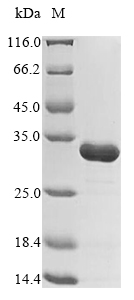Recombinant Mycobacterium paratuberculosis Probable transcriptional regulatory protein MAP_1030 is expressed in a yeast system as a full-length protein consisting of amino acids 1-250. The protein includes an N-terminal 6xHis-tag, which makes purification and detection straightforward. SDS-PAGE analysis shows it reaches a purity level greater than 85%, making it suitable for various research applications. This product is intended for research purposes only and is not for clinical use.
MAP_1030 appears to be a transcriptional regulatory protein from Mycobacterium paratuberculosis. It likely plays a role in gene regulation, though its exact function may involve influencing the transcription of specific genes within the bacterium. Research into the function and regulation of such proteins seems crucial for understanding bacterial gene expression and regulatory mechanisms. Studies of MAP_1030 might provide insights into the complex pathways and interactions within Mycobacterium species.
Potential Applications
Note: The applications listed below are based on what we know about this protein's biological functions, published research, and experience from experts in the field. However, we haven't fully tested all of these applications ourselves yet. We'd recommend running some preliminary tests first to make sure they work for your specific research goals.
Based on the provided information, recombinant Mycobacterium paratuberculosis MAP_1030 is produced in a yeast expression system as a full-length protein (1-250aa) with an N-terminal 6xHis-tag. Yeast expression systems provide eukaryotic folding machinery capable of supporting disulfide bond formation and some post-translational modifications, which may aid in proper folding for this transcriptional regulator. The full-length nature of the protein increases the probability of correct folding. However, transcriptional regulatory proteins often require a precise three-dimensional structure for DNA-binding and functional activity, and the His-tag could potentially interfere with folding or function. Purity >85% by SDS-PAGE is determined under denaturing conditions and does not confirm native folding or bioactivity. No validation data (e.g., DNA-binding assays, circular dichroism) are provided. Therefore, while yeast expression suggests a reasonable chance of correct folding, the protein's folding status and bioactivity cannot be confirmed without experimental validation.
1. Protein-Protein Interaction Studies
Protein-protein interactions depend on native conformation; misfolding compromises binding specificity. If correctly folded, the recombinant MAP_1030 can be used in pull-down assays to identify interaction partners, as the His-tag facilitates immobilization. However, if misfolded, interaction domains may be altered, leading to non-specific binding or failure to recognize genuine biological partners, compromising the validity of regulatory network studies.
2. DNA-Protein Interaction Analysis
DNA-binding functionality requires precise folding; structural defects would render interaction studies biologically irrelevant. If properly folded, the protein can be used in EMSA or surface plasmon resonance to study DNA-binding properties. However, if misfolded, DNA-binding domains may be disrupted, resulting in invalid binding data and incorrect conclusions about transcriptional regulation.
3. Antibody Development and Validation
Antibodies can be generated against linear sequences, but conformational epitopes may be misrepresented if the protein is misfolded. This application is suitable as antibody generation primarily relies on linear epitope recognition, which is independent of folding status. The full-length protein provides comprehensive epitope coverage. However, if misfolded, antibodies may not optimally recognize conformational epitopes of the native protein in biological contexts.
4. Structural and Biophysical Characterization
Structural studies require proper folding to generate biologically relevant data. If correctly folded, the protein is suitable for structural studies like X-ray crystallography or biophysical analysis like circular dichroism. However, if misfolded, structural data would misrepresent the native protein's architecture, leading to erroneous insights into function.
5. Comparative Mycobacterial Studies
Comparative analyses require native activity and structure to ensure meaningful evolutionary insights. If functionally active and properly folded, the recombinant MAP_1030 enables valid comparative studies with orthologs from other mycobacteria. However, activity validation is essential first, as improper folding would make cross-species comparisons misleading.
Final Recommendation & Action Plan
Before employing this recombinant MAP_1030 in any functional application, it is essential to validate its folding and bioactivity through biophysical methods (e.g., circular dichroism for secondary structure, size-exclusion chromatography for oligomeric state) and functional assays (e.g., DNA-binding tests using known promoter sequences); if validation confirms proper folding and function, proceed with applications while considering potential tag interference; if misfolded, consider using tag-free protein or alternative expression systems (e.g., mycobacterial systems) for better physiological relevance; for immediate use, antibody development can proceed but validate antibodies against native protein; avoid functional studies until proper folding and bioactivity are confirmed. Always include appropriate controls (e.g., known DNA probes, interaction partners) in experiments to ensure reliability.






